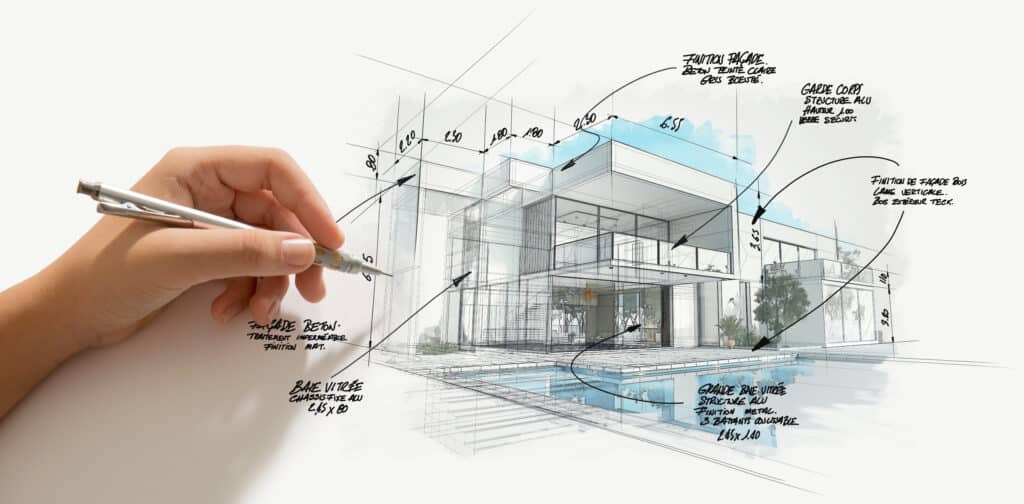Understanding the Diverse Career Paths Available for Aspiring Architect
As a hopeful Architect, you have a globe of profession paths waiting for you. Each course supplies special difficulties and possibilities to apply your creativity and technological know-how. Whether you're attracted to conventional style or the nuances of lasting style, there's a niche that lines up with your interests. Comprehending these diverse choices can shape your expert trip, however which instructions will you choose to discover first?
Standard Design: Creating Frameworks and structures
Typical design focuses on making buildings and structures that mix capability with visual allure. As you discover this area, you'll appreciate the elaborate balance between form and function. You'll find out to draw ideas from historic styles, integrating aspects like proportion, materials, and craftsmanship. Your layouts can mirror cultural heritage, showcasing local customs while satisfying modern-day requirements.
You'll develop abilities in composing, model-making, and site analysis, enabling you to envision and communicate your ideas successfully. Engaging with clients, you'll require to comprehend their vision and translate it right into possible layouts.
Moreover, building codes and sustainability practices are vital in your work, ensuring your frameworks are secure and eco-friendly. As you grow in your career, you'll discover opportunities in property, business, or even reconstruction jobs, each offering distinct obstacles. Welcoming traditional design paves the way for a fulfilling job that admires the past while shaping the future.
Urban Planning: Shaping Communities and Public Spaces
As an ambitious Architect, you can play a vital role as an urban coordinator, transforming exactly how communities communicate and function. By using community interaction methods, you'll assure that citizens have a voice in shaping their setting. And also, integrating lasting style concepts will certainly aid develop rooms that not just satisfy today's demands however additionally secure the future.
Duty of Urban Planners
While several might think of designers as the single dreamers behind structures, city coordinators play an important function in shaping the wider landscape of neighborhoods and public spaces. By collaborating with various stakeholders, you'll help design parks, transportation systems, and residential locations that advertise social communication and access. Your competence in spatial style and area characteristics enables you to visualize future growth while maintaining social heritage.
Neighborhood Interaction Techniques
Reliable area engagement strategies are important for city organizers to guarantee that the voices of citizens are listened to and valued in the preparation process. To foster significant discussion, you need to focus on open discussion forums and workshops where community members can reveal their concepts and worries. By proactively incorporating and listening comments, you'll produce rooms that mirror the area's demands, inevitably leading to even more lasting and effective urban environments.
Lasting Design Principles
When designing city areas, integrating sustainable layout concepts is important for creating environments that grow both environmentally and socially. Think about integrating environment-friendly rooms, like gardens and parks, to boost biodiversity and enhance air top quality.
Creating with water conservation in mind is additionally vital-- think of rainfall gardens and absorptive surfaces to take care of stormwater. Including community participants during the preparation process guarantees that the rooms you produce fulfill their requirements and encourage social communication. By embracing these concepts, you'll add to lively, sustainable city landscapes that benefit every person.

Landscape Architecture: Creating Lasting Exterior Atmospheres
As you explore landscape architecture, you'll uncover necessary style principles that create practical and gorgeous outdoor rooms. Sustainable practices play a vital function in making sure these environments grow while lessening environmental influence. And also, you'll find a selection of profession opportunities that enable you to make a real distinction in how individuals communicate with nature.
Design Principles in Landscape
Understanding style principles in landscape design is important for developing lasting outdoor settings that harmonize with nature. You'll require to contemplate aspects like proportion, range, and balance to ensure your designs really feel natural and welcoming. Integrating indigenous plants not only improves biodiversity yet also minimizes water usage, making your landscape durable. Assume about the flow of room and how people engage with it; paths and seating areas must welcome exploration and relaxation. Furthermore, pay attention to seasonal modifications, making with materials that enhance the surroundings year-round (Architect). By prioritizing sustainability and visual appeals, you can develop outdoor areas that enhance the community and promote health. Embracing these principles will certainly establish a strong foundation for your occupation in landscape architecture.
Sustainable Practices Summary
Sustainable methods in landscape architecture not only concentrate on aesthetic appeals yet likewise prioritize ecological wellness and resource conservation. By incorporating indigenous plants, you boost biodiversity and reduce the demand for chemical plant foods and pesticides. Executing efficient watering systems assists save water and reduces runoff, shielding close-by environments. You can develop spaces that advertise soil health, such as exercising and utilizing natural products permaculture principles. In addition, integrating green infrastructure, like rainfall gardens and permeable pavements, help in stormwater management and reduces metropolitan heat. When you develop outside atmospheres with sustainability in mind, you add to a healthier planet and supply spaces that promote community link. Inevitably, these practices assure your designs profit both individuals and the atmosphere for several years to find.
Career Opportunities Expedition
With a solid structure in sustainable check here practices, landscape style offers a selection of job courses that allow you to make a meaningful influence on the atmosphere. Urban coordinators often team up with landscape engineers to create environment-friendly areas in metropolitan setups, enhancing city livability. If you're enthusiastic regarding education and learning, take into consideration ending up being a landscape architecture teacher, inspiring future generations.
Lasting Style: Focusing on Eco-Friendly Practices
As you discover your career in style, accepting environment-friendly practices can here establish you apart in a competitive area. Sustainable style concentrates on producing structures that decrease ecological impact while boosting occupant wellness. By integrating eco-friendly materials, energy-efficient systems, and lasting building methods, you'll contribute to a greener future.
Beginning by obtaining understanding of green qualifications like LEED or BREEAM, which can bolster your qualifications. Take into consideration how all-natural light, air flow, and thermal efficiency can maximize design. Team up with designers and environmental experts to introduce solutions that decrease waste and preserve sources.
Don't forget the value of area involvement-- engaging regional stakeholders can influence layouts that integrate with the environment. As clients progressively focus on sustainability, your knowledge in green techniques will not only attract projects however likewise meet your interest for liable style. Welcome this crucial aspect of the occupation, and enjoy your occupation grow.
Historical Conservation: Shielding and Recovering Social Heritage
While you start on your building trip, consider the important function of historic preservation in maintaining our social heritage. This area concentrates on the security and remediation of significant buildings, websites, and frameworks that inform the stories of our past. By participating in historic conservation, you'll help protect the architectural legacy that forms area identification.
As a historic conservation Architect, you'll assess historic importance and assess the problem of structures. You'll function carefully with historians and preservationists to assure authentic restoration methods are employed. This job path permits you to blend creativity with research study, enabling you to make options that respect initial materials and workmanship.
Your work not only adds to sustainability by reusing existing structures but additionally promotes a sense of satisfaction within communities. Welcoming this course will help you come to be a guardian of background, protecting the stories and appearances that improve our lives.
Interior Architecture: Enhancing Indoor Spaces
Historic conservation and indoor style both share check here a dedication to improving the developed atmosphere, but they concentrate on various aspects. While historical conservation highlights keeping a structure's social and historical value, indoor design absolutely nos in on enhancing interior spaces for functionality and visual appeals.
As an ambitious Architect, you'll find that indoor design allows you to mix creative thinking with technical skills. You'll create spaces that not only look great yet likewise advertise comfort and effectiveness. This area entails understanding exactly how light, shade, and products interact within a space, impacting state of mind and use.
You'll deal with different tasks, from property homes to commercial workplaces, making sure that each setting meets the requirements of its passengers. By focusing on individual experience, you can transform interiors into practical and inspiring spaces, making a considerable influence on exactly how people communicate with their environments. Embrace the possibility to boost interior atmospheres and form the method people live and work.
Industrial Layout: Combining Capability With Aesthetics
Industrial style plays an important function in developing products that effortlessly mix aesthetics with capability, ensuring that what you use day-to-day is not just aesthetically attractive however also useful. As a hopeful Architect, you could immerse on your own in this field, focusing on designing whatever from furniture to consumer electronics. Your job entails understanding user needs, materials, and manufacturing procedures, enabling you to produce ingenious remedies that enhance day-to-day experiences.
In commercial layout, you'll frequently work together with engineers, producers, and marketing professionals, guaranteeing that your styles are not only stunning however likewise possible. This profession path offers a dynamic setting where creative thinking fulfills usefulness, making it a satisfying option for designers interested in shaping the products of tomorrow.
Often Asked Concerns
What Educational Credentials Do I Need to Come To Be an Engineer?
To end up being a designer, you'll need a specialist level in architecture, generally a Bachelor's or Master's. Additionally, you'll need to complete an internship and pass the Architect Registration Examination to exercise legally.
Exist Qualification Demands for Different Building Occupation Paths?
Yes, there're certification requirements for numerous architectural courses. Architect. You'll require to pass exams, complete teaching fellowships, and often pursue specialized training, relying on your picked focus, like landscape architecture, metropolitan design, or historical preservation
What Software Abilities Are Important for Engineers Today?

Exactly How Can I Gain Practical Experience While Examining Style?
You can get useful experience by interning at building firms, joining style competitions, volunteering for neighborhood jobs, or collaborating with schoolmates on real-world projects. These opportunities boost your skills and construct useful connections in the market.
What Job Opportunities Exist Outdoors Conventional Architecture Firms?
You can check out various task opportunities outside standard architecture companies, like urban preparation, interior decoration, landscape style, building management, property development, or perhaps roles in sustainability consulting. Each deals unique obstacles and rewards.
Whether you're attracted to traditional design or the subtleties of sustainable style, there's a niche that lines up with your passions.When developing city spaces, including sustainable layout principles is crucial for developing atmospheres that thrive both environmentally and socially.As you check out landscape architecture, you'll find essential style concepts that create practical and gorgeous exterior spaces.Comprehending layout principles in landscape design is essential for developing sustainable outdoor settings that harmonize with nature.In industrial style, you'll commonly team up with marketing experts, designers, and suppliers, guaranteeing that your styles are not only stunning however also possible.